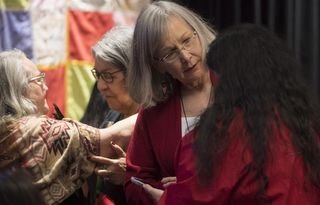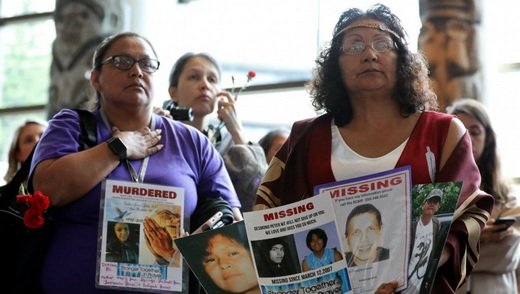Reclaiming Power and Place.
Political statistics register 1,181 Indigenous women missing or murdered between 1980 and 2012 across Canada. The same trend continues until the present day. Patricia Hajdu, former minister for women, reckons the number can reach the 4,000 cases, because a lot of them have not been reported. The problem is so alarming that Canadian Prime Minister ordered an inquiry three years ago. Marion Buller, Chief Commissioner, began her intervention in the ceremony for the release of the final report, stating : “This report is about deliberate race, identity and gender based genocide”.

The 1,200-page final report has 231 recommendations, which are legal imperatives. Some of them : the creation of a national action plan to address violence against Indigenous women ; to develop laws, policies and public education campaigns to challenge the acceptance and normalization of violence ; it calls for equitable access to employment, housing, education, safety and health care ; promotion of Indigenous women to leadership positions.

The Prime Minister of Canada, Justin Trudeau, declared : “We must continue to decolonize our existing structures, and the racism, sexism and economic inequality that has allowed such violence against Indigenous women and girls to prevail must be eradicated”. Data : Indigenous women and girls made up 16 per cent of all female homicides between 1980 and 2012, despite comprising just 4 per cent of the population. Their violent victimization rates were triple those experienced by non-Indigenous women, and the rate for women was more than double the rate for Aboriginal men. It is evident that Indigenous women are the country´s most vulnerable citizens simply by virtue of being Indigenous and female. The conclusion of the inquiry is that the disproportionate rate of violence against Indigenous women is a direct consequence of hundreds of years of colonialism and discrimination. Systemic racism, sexism and colonialism have produced “institutional violence”, perpetuated by institutions such as the military, the church, the educational system, the health system, the police and justice system. The colonial and patriarchal policies displaced women from their traditional roles in communities and diminished their status in society, leaving them vulnerable to violence. And as Trudeau said : this is “not a relic of our past”.

The report issued a 43-page analysis of genocide. Article 2 of the 1948 United Nations´ Convention on the Prevention and Punishment of the Crime of Genocide defines genocide as “acts committed with intent to destroy, in whole or in part, a national, ethnical, racial or religious group.” The convention goes on to divide genocide into two elements : the mental (the “intent to destroy, in whole or in part, a national, ethnical, racial or religious group”) and the physical (which includes the “killing of members of the group, causing serious bodily or mental harm to members of the group, deliberately inflicting on the group conditions of life calculated to bring about its physical destruction in whole or in part, imposing measures intended to prevent births within the group and forcibly transferring children of the group to another group”). Using this extended definition developed by the United Nations, not only in Canada, but all throughout the Americas, Australia and the countries colonized by European nations, Indigenous people suffered genocide. Regarding the neighbouring country, the United States, openly practiced genocide as they cleared the country for settlement. General Philip Sheridan is reported to have coined the phrase “the only good Indian is a dead Indian”. In Canada the work was done by bureaucracy and missionaries, so the practice became “the only good Indian is a white Indian”. A senior official in the Indian Affairs Department, Duncan Campbell, wrote in 1920 that the aim was to “kill the Indian in the child” until “there is not a single American Indian in Canada that has not been absorbed”.
Pn the years following Canada´s birth as nation in 1867, treaties were signed between the Federal Government and the Indigenous Peoples. The treaties are signed among partners. The events that followed the signing were so far from the truth. The Indigenous nations were treated like prisoners rather than partners. Bands were quite literally starved off of their traditional lands and forced to move onto reserves, which can be seen as an act of inflicting conditions of life calculated to bring about its physical destruction, as stated in the United Nations definition of genocide. Also, over the years, numerous Indigenous women have been sterilized without their consent ; the practice has been reported to exist to the present day- another item in the United Nations Convention. Regarding children forcibly transferred to another group, Canada has the sad legacy of boarding schools directed by missionaries, where all Indigenous children were forcibly moved, in the hope that they would lose the Indian in the child, and where a lot of physical, psychological and sexual abuse was committed. As well there was the transfer of Indian children to white families, creating people without roots in either white society or their home reserve society. All these fit the definition of genocide as declared by the United Nations Convention. So, according to the Convention of 1948 and as established in the Final Report, Canada is guilty of committing genocide against their Indigenous peoples.

Canada is a success in many ways : It has developed a political system that works, despite its cultural and linguistic divisions. It welcomes citizens from all around the world, a lot of them having arrived as refugees (recently the United Nations High Commissioner for Refugees- UNHCR, congratulated Canada for its generosity in welcoming). In fact, one in every five Canadians was born beyond its borders. It is a truism that the more the country has accommodated diverse cultures, the stronger it has become. The one big failure and a bleeding wound is her treatment of her Indigenous peoples. The report presents a hard reality not easy to look at, but the fact that the inquiry has been done and their results officially welcomed, it is an honour for the country. To implement the recommendations, the whole society must be committed, not only the official institutions, because the commission called on everyday Canadians to help “decolonization” by becoming strong allies, the Indigenous and Non-Indigenous peoples together. Justin Trudeau, the Prime Minister of Canada, declared to the Indigenous people in the ceremony for the release of the final report : “We have failed you. But we will fail you no longer”. May we be faithful in living out the message of our Prime Minister. This report is a landmark in the history of Canada, and without doubt, makes a valuable contribution to the larger debate, long-term.

